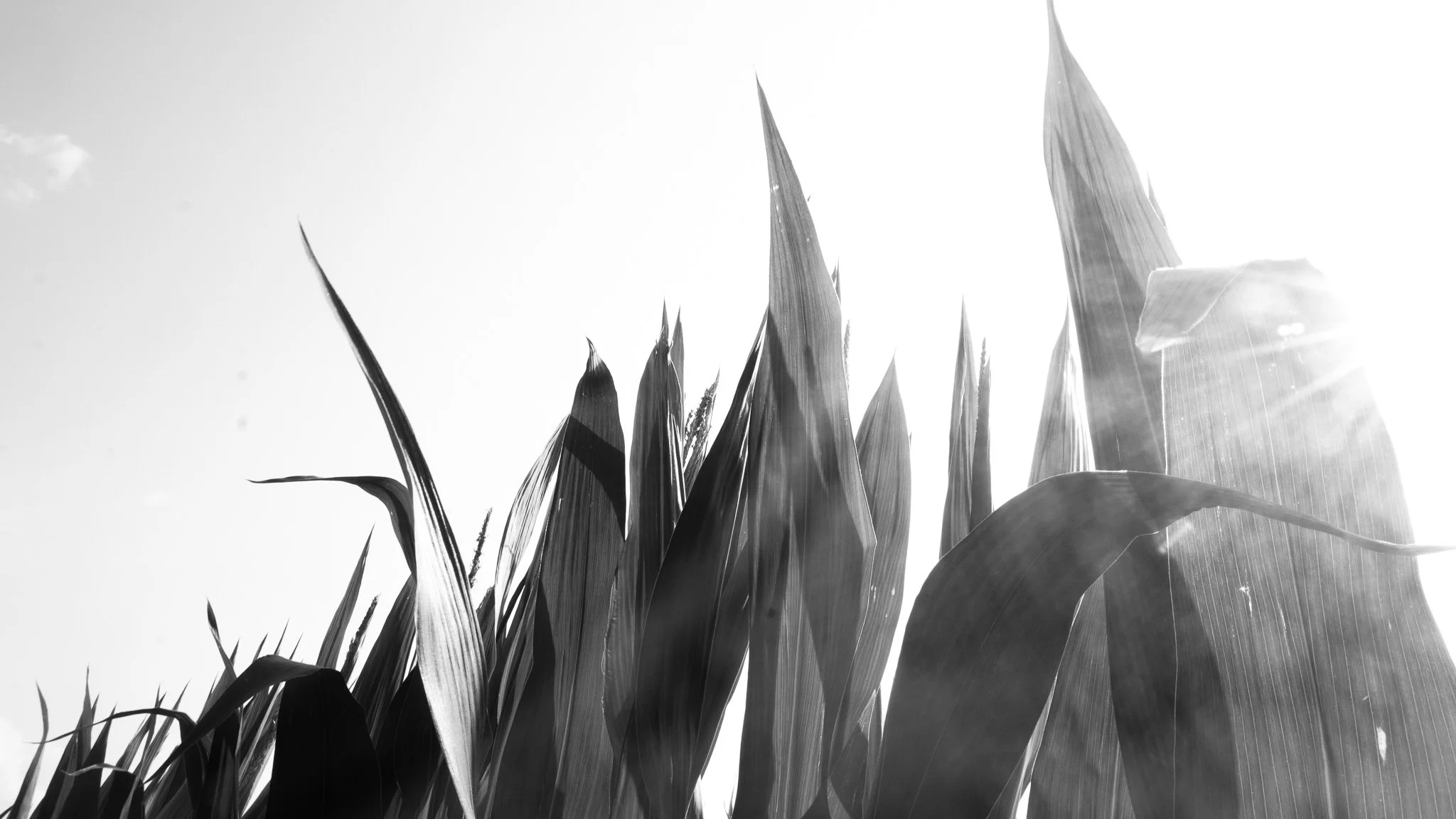John Aguzzi
Cleveland, MS
John Aguzzi, 76, is a family man and a farmer. To survey the vast expanses of Aguzzi farm, upon which large tracts of soybean and rice grow, is to recognize that the two roles, to him, are virtually indistinguishable.
From the moment we arrived at the intersection where he resides––known to locals as Aguzzi’s corner––we were met with a warm gust of Southern hospitality. Aguzzi and his wife invited us into their home, offered mugs of peppermint tea, and proffered bumper stickers that declared: EAT RICE. POTATOES MAKE YOUR BUTT BIG.
A lifetime in the sun has earned Aguzzi a coarse bronze tan that he wears with pride. His right ring finger bore the reminder of an unfortunate encounter with farming machinery. In conversation, he is a lively storyteller, quick to smile but sharp as a tack. While experienced in the physical matter of tending to a farm, he is also adroit with numbers, having taken accounting courses at Delta State. A businessman who is both pragmatic and friendly, he rents farmland out to neighbours at a relatively low price.
His easygoing nature belies a work ethic made undeniable by the 9,000 acres of farmland that stretches from and beyond Aguzzi corner. After our structured interview, Aguzzi volunteered to show us around his land, which, by his account, comprises nearly 3,500 acres of rice and 6,000 acres of soybeans. Every year, they alternate what they grow on different parts of their land: rice one year, soybeans the next, and repeat.
In his truck, he navigated narrow, linear dirt roads that cut through the fields with the deftness of a child wandering their favourite candy aisle in the supermarket. Verdant fields of rice unfolded before us, water glistening at the roots.
As the truck rumbled along, flanked on both sides by his crops, Aguzzi came alive. He drove with one hand on the steering wheel and the other in the air, waving, gesticulating, and pointing at crucial features of the farmland. Here was the pump that provides the rice crops with a regular source of water; there was an older grain silo the farm rarely uses.
When we stopped to look around, I asked how much of the land before us – rows upon rows of rice and soybean crops, flawless in their uniformity – was his.
“You see those trees out there?” Aguzzi directed our attention to the stretch of hardwood trees in the far distance, obscuring the horizon from view. Above us, the sun that has borne witness to generations of Aguzzis in the Delta blazes on; here, then, was Mississippi heat.
“That’s where our land ends.”
In 1896, Aguzzi’s great-grandfather immigrated to America. Back in Italy, opportunities were scarce: there were few jobs, and the family spent most of their time maintaining a cemetery. The allure of regular employment and potential upward mobility drew them to a plantation in Sunnyside, Arkansas, beside Greenville Bridge, which traverses the delta between Arkansas and the Mississippi.
According to their employers, the Aguzzis could eventually come to pay for part of the land –– to call it their own. The family, many of whom did not speak English, accepted this “deal.” But one particularly astute member of the family did the math and soon discovered that the deal was a sham: earning enough to pay for any part of the land was an impossibility. They would never own it. After a year, they left the plantation, never to look back.
As such, many Italian immigrants like the Aguzzis found themselves scattered across America. Some remained in Greenville, MS, while others moved further north in Arkansas. Others still travelled up to Colorado in search of better prospects. The Aguzzis themselves went to Shelby, MS, to work as sharecroppers.
“They had nothing,” Aguzzi stated. “...But their dream was to have their own [land].” They moved again, to Merigold, then Boyle, and finally, to Cleveland, MS.
And so the Aguzzis kept “saving and saving and saving,” Aguzzi says. In time, they had purchased forty acres of land and a Ford Model T, a popular automobile at the time. But they still walked, rather than drove, into town. Pressed by his son to explain why, Aguzzi’s grandfather said: “We save that gas to go to church on Sundays with clean clothes.”
The Aguzzis lived frugally, eating the corn they grew, making their own flour, and saving every last penny. Soon, they had purchased another forty acres of land.
While farming their own land, the Aguzzis also rented land from others. Once, Aguzzi’s father, Joe Aguzzi – a veteran of the Second World War with a Purple Heart to show for it – went to pay his landowner rent, only to discover that the land had already been rented out to someone else at a higher cost. “Well, he offered me more money,” said the landowner.
Determined never to repeat the experience, Joe Aguzzi began saving money and buying land with renewed intensity. As of 2025, the Aguzzis own approximately 9,000 acres of land in Bolivar County, MS, growing rice and soybeans at a scale unrivalled by any neighbouring farmers.
Now, Aguzzi’s three brothers, two paternal cousins, and their sons and grandsons work on the farm. Between school, football practice, and soccer practice, the grandsons find time to work during the summer months. In his office, Aguzzi gestured towards a photo on the wall featuring the men of the Aguzzi family in the foreground, the farmland behind them extending towards the horizon under the midday sun.
“It’s a large family farm,” Aguzzi told us. A close-knit family, to him, is everything: his son lives close by, on the same side of the road; his daughter, on the other side. His second daughter is just two lots down the field. His grandchildren live with his children, and frequently come to help with the farm.
“That’s my biggest joy,” he said. “…You couldn’t blow me away from this place.”
““You couldn’t blow me away from this place.””
As Catholics, the Aguzzis never work on Sundays. Any other day of the week, however, and the game is on: the clock is ticking. Rice must be planted by April the first. Soybean must be cut by August the first. And rice, again, must be gathered with combine harvesters by October the first.
Aguzzi’s knowledge of farming is technical, intricate, and extensive, an accumulation of his family’s work through the decades. In conversation, he explained the rationale behind employing their own grain silos (there are often long lines at external grain elevators, which are costly and fritter away precious farming time), the relative dependency of farming rice (unlike growing cotton or soybeans, more “hit-or-miss” endeavours), and the large and cumulative expenses that come with farming (as they purchase herbicides and farming equipment that costs the equivalent of a house).
As he drove, he indicated the levees in the rice field, lengthy parallel mounds of dirt which regulate the quantity of water covering the patty. From time to time, the height and size of the levees is modified with the help of heavy machinery.
“Farming is…a gamble,” Aguzzi said. In the past, he grew soybeans that reached a foot in height, only for rain to flood the farmland, covering the crop with water for up to two weeks. A race to replant all of the crop followed; with such cases, a successful harvest is never guaranteed.
Before modern varieties of the crop entered the scene, some of the soybeans on the Aguzzis’ farm were only ready for harvest in November. However, the weather worsened as the season progressed, reducing acres of ground to mire. To harvest their crops, the Aguzzis had to wait until early morning, when the ground froze over, stopping at ten to eleven when it began to thaw once more.
But this doesn’t always work, Aguzzi said, referencing a story from his youth. In the absence of four-wheel combines with rear wheel assists, which are capable of escaping the clutches of muddier ground, one combine got stuck. First, they attempted to pull the combine out with another one, but that one succumbed as well. Further unsuccessful efforts ensued.
“Every piece of equipment we had was stuck in the mud,” Aguzzi recalled. Four or five combines were immovable where they stood, some nose-to-nose due to failed attempts to push a combine out backwards with another. Some tractors were also trapped.
A friendly neighbour with a new four-wheel drive interceded, helping to drag all of their equipment out of the sludge. The Aguzzis learned their lesson. All of their current combines are four-wheel drives; the tractors are reinforced with rubber tracks for greater accessibility.
Over time, the challenges of farming have evolved. A particular roadblock, in recent years, has involved government regulations and bureaucracy.
While Aguzzi described being “all for” water consciousness, he expresses frustration with the Environmental Protection Agency’s various stipulations, such as adding water meters to wells.
“The paperwork is unreal,” he admitted. He felt optimistic, however, towards the current administration’s efforts to minimise bureaucracy and agricultural costs.
Was it all worth it? Aguzzi seemed to think so. Despite the tribulations that accompany a lifetime of farming, his joviality shone through. “If you aren’t eating rice, eat rice,” he said, smiling. “If you are eating rice, eat more rice. ‘Cause my livelihood depends on it.”
EAT RICE. POTATOES MAKE YOUR BUTT BIG.
•
EAT RICE. POTATOES MAKE YOUR BUTT BIG. •
At the end of the day, Aguzzi invited us to climb up one of his grain silos.
The railings and other safety measures, he informed us, were added by him; prior to that, the ascension was perilous. Aguzzi himself is spry, and completed the steps up to the catwalk without so much as breaking a sweat. Still, the height is dizzying, and –– looking down –– there came the inevitable lurch of vertigo.
Upon reaching the summit, Aguzzi keenly pointed out the rotors on the very top of the silo that serve to dry out the grain. We then descended a short ladder back down to the catwalk ringing the top of the silo.
Aguzzi regarded his land, sprawling and endless under the setting sun. He leaned forward against the railing on one side of the silo. Though loquacious throughout our conversations, he had abruptly –– and uncharacteristically –– fallen silent. I looked at him, concerned; is something wrong?
It took a moment to register: the look of fullness in his eyes, the quiet pleasure in the slight, near imperceptible curve of a quiet smile.
One recalled Fitzgerald’s Carraway, “compelled into an aesthetic contemplation he neither understood nor desired,” although this time it was Aguzzi, rendered silent with awe in the presence of his own land.
This, here, was a man content.










